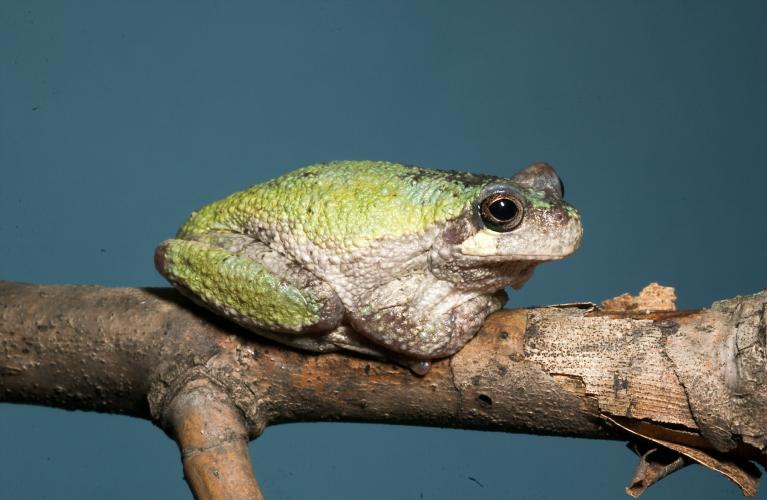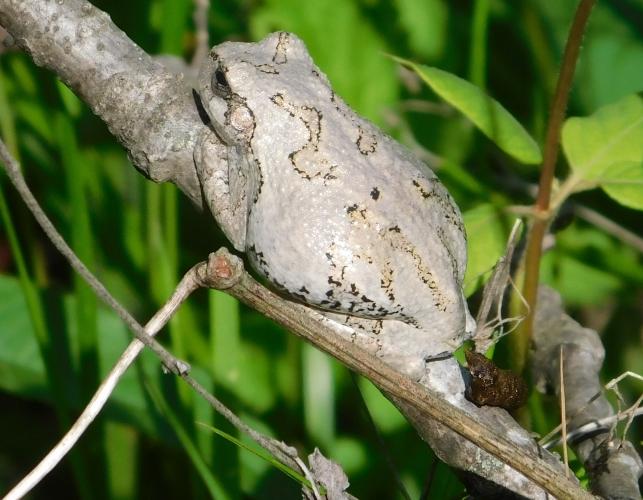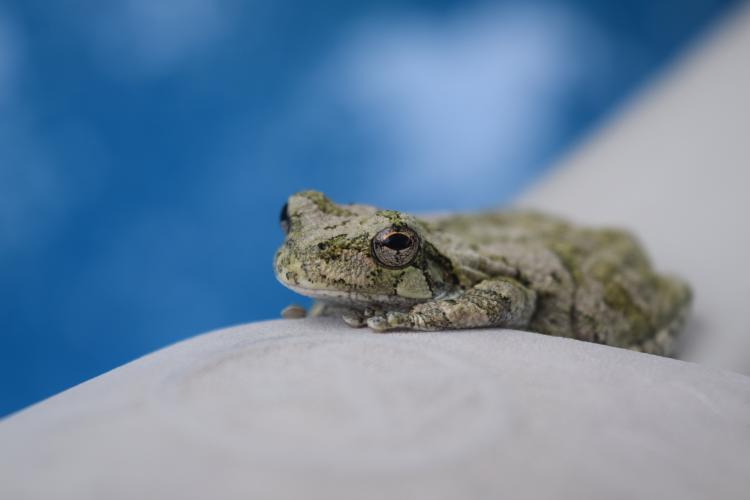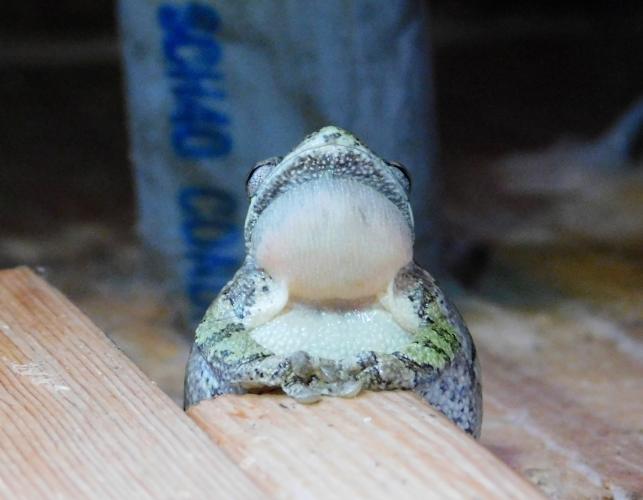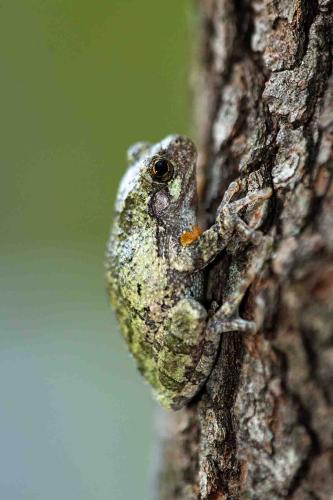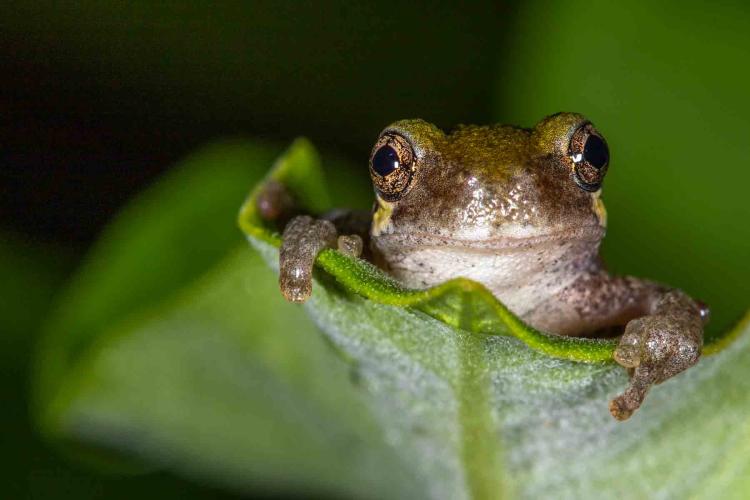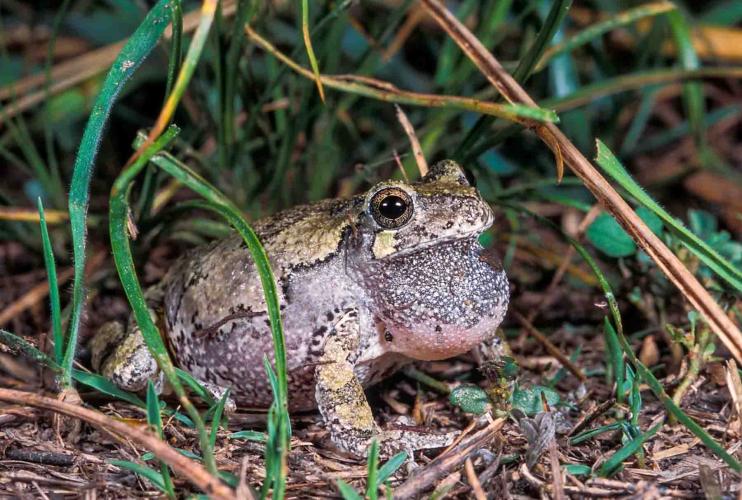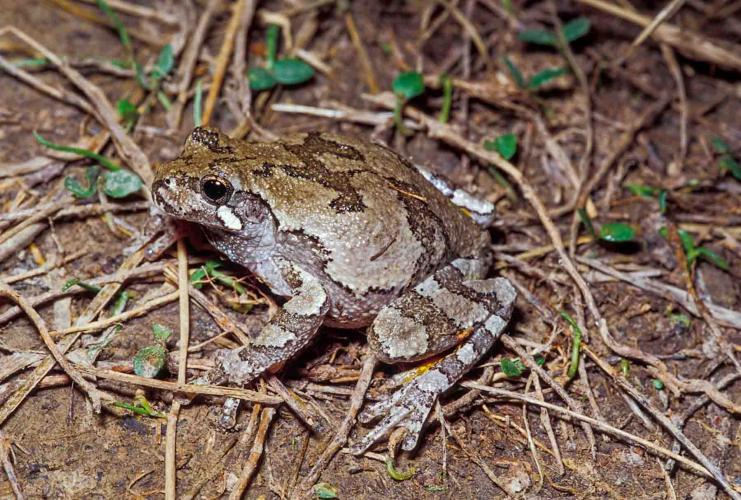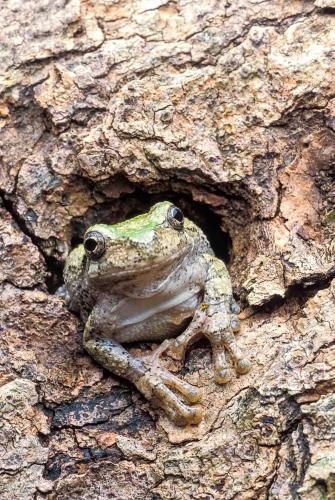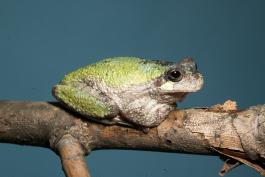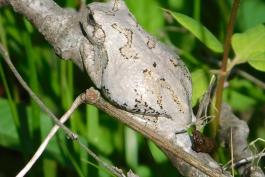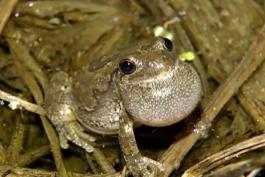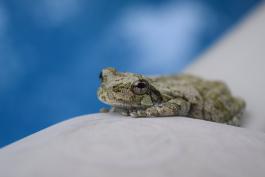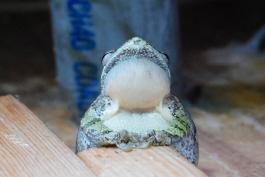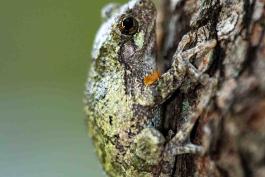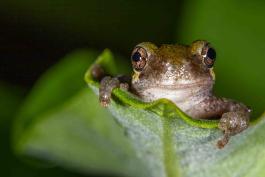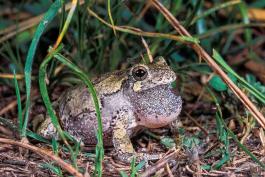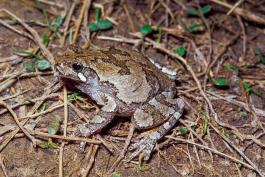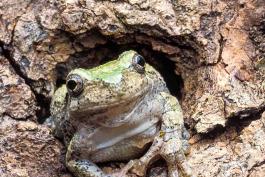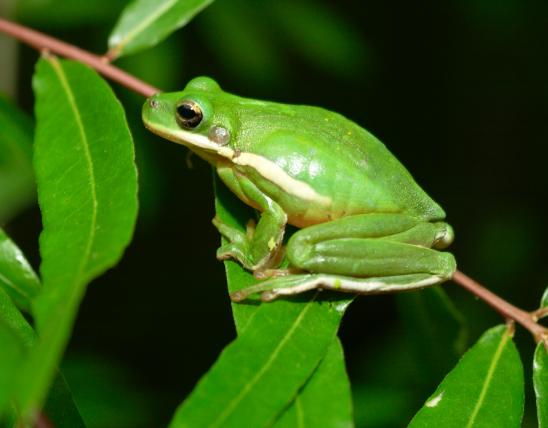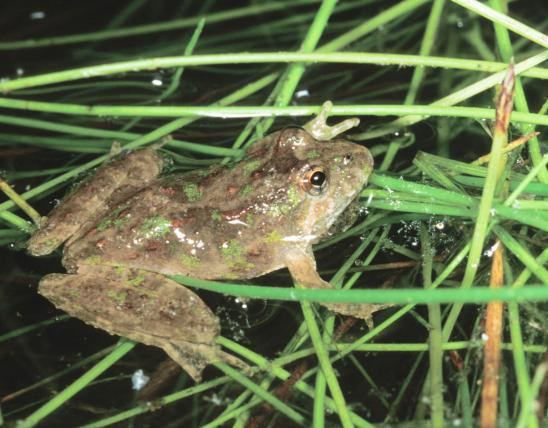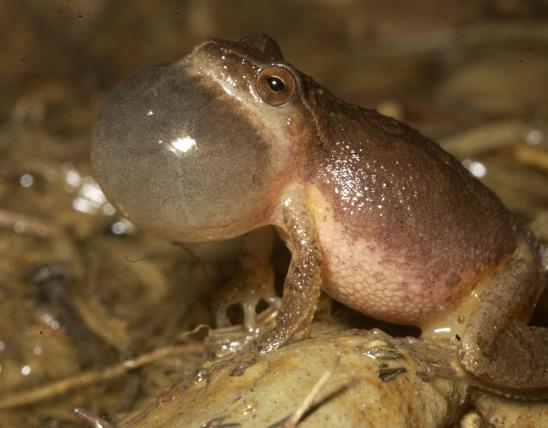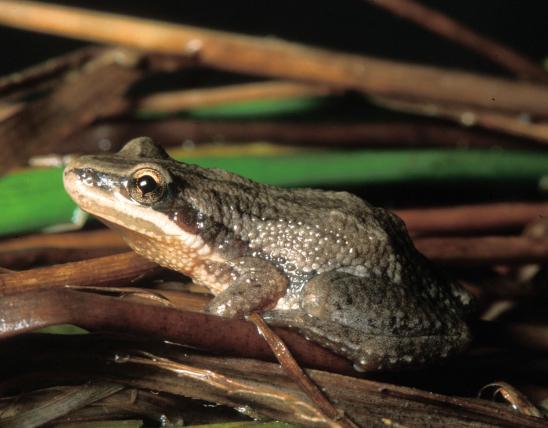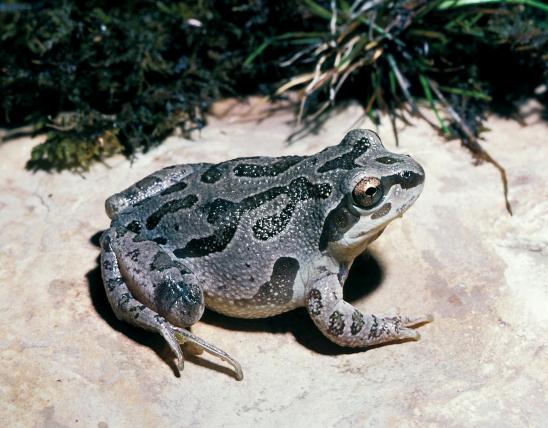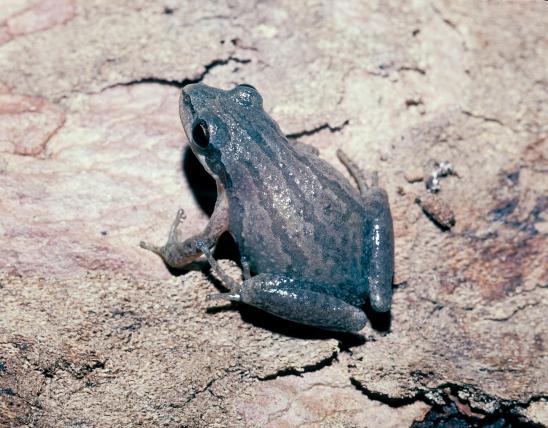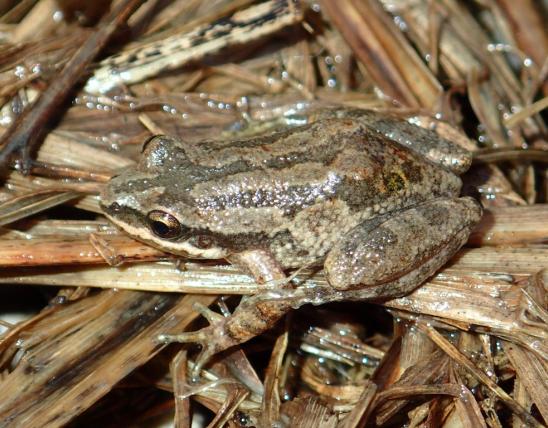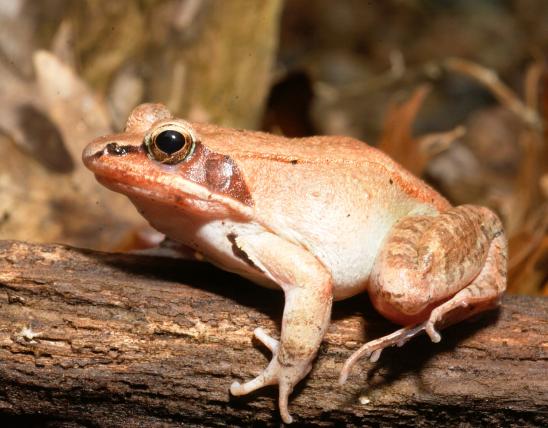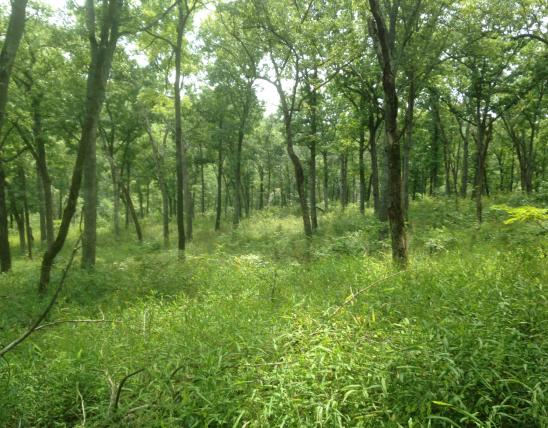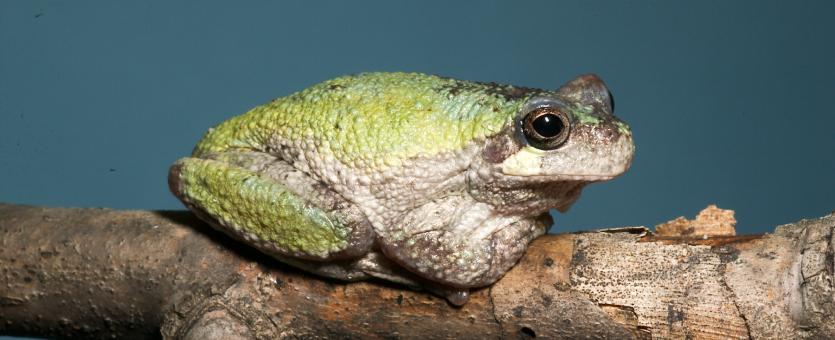
These two species — the gray treefrog and Cope’s gray treefrog — are very similar. Because they are so similar, they are combined on this page. Both species have warty (granular) skin and adhesive pads on fingers and toes. The color may be green to light greenish gray, gray, brown, or dark brown. Except for very light individuals, the back usually has a few large, irregular dark blotches. (These frogs are well-camouflaged against a background of lichen-covered tree bark.) There is always a large white or gray spot below each eye. The belly is white to cream. The area inside of the hind legs is yellow or orange yellow, with gray or black mottling.
Although both species of gray treefrogs in Missouri are basically identical, the Cope's gray treefrog tends to be slightly smaller and is more often green than the gray treefrog.
One of the better ways to distinguish between the two species is by ear. The call of the gray treefrog (H. versicolor) is a musical birdlike trill. The call of Cope’s gray treefrog (H. chrysoscelis) is a high-pitched buzzing trill. Amateurs can learn to distinguish between them, with practice. The method is somewhat complicated by the fact that varying air temperatures change the pitch and timbre. Scientists can use sonograms (graphic representations of the voice) to analyze and document the number of pulses per second.
Some authorities place North American treefrogs (traditionally in genus Hyla) in genus Dryophytes; in that system, the gray treefrog is Dryophytes versicolor and Cope’s gray treefrog is Dryophytes chrysoscelis.
Similar species: The green treefrog (Hyla cinerea) is the only other treefrog in Missouri, and it is indeed truly green. A light stripe runs from the upper lip down the side of the body. In Missouri, it occurs mainly in the southeastern corner, in swampy lowlands. Missouri represents the northwestern limit of the green treefrog's total range. The green treefrog seems to be expanding its range north and west along into Ozark rivers and streams that border the Bootheel lowlands. The green treefrog also occurs in several isolated, apparently introduced populations elsewhere in the state.
Body length: usually 1¼ to 2½ inches (snout to vent). Occasionally larger.
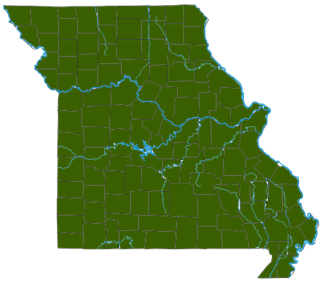
Statewide. The gray treefrog (H. versicolor) occurs in northeastern, eastern, southern, and central Missouri. Cope’s gray treefrog (H. chrysoscelis) occurs in eastern, southeastern, northwestern, and western Missouri. The two species are often found in the same counties.
Habitat and Conservation
These two treefrogs appear to have the same general habits and habitats in Missouri, though the gray treefrog (Hyla versicolor) seems to be more of a forest species, while Cope's gray treefrog (H. chrysoscelis) is more associated with grasslands and oak savannas.
Both species are woodland dwellers and live in small woodlots, in trees along prairie streams, in large tracts of mixed hardwood forests, and in bottomland forests along rivers and in swamps. In summer, they spend much of their time in the canopy of deciduous woods, hiding in cracks, crevices, knotholes, bird holes, and other cavities. They are often rest with their heads protruding from the opening; they often return repeatedly to the same cavity.
People often see them around and near houses and other human-built structures. In these areas, look for them resting among leaves in yards or hiding in nooks of farm buildings, on porches and decks, in gutters, in birdhouses, and climbing on windows at night. Treefrogs often perch near porch lights at night, where they hunt insects attracted to the light.
They usually overwinter, dormant, in soil beneath leaf litter, there the moisture and temperature conditions are more suitable than they would be in tree cavities aboveground. Gray treefrogs do not have to overwinter below the frost line because their liver produces blood antifreeze chemicals that prevent freeze damage to their tissues. The two species produce different cryoprotectants: the gray treefrog (H. versicolor) has glycerol and glucose, while Cope's gray treefrog (H. chrysoscelis) has only glucose. They can withstand temporary freezing events, but prolonged freezing may be fatal.
Food
These treefrogs eat insects, spiders, and other invertebrates; ants and beetles can make up nearly three-fourths of the diet.
Status
Common.
Life Cycle
In Missouri, gray treefrogs are normally active from late March through October. They breed from early April to early July, but sometimes into August. When the nighttime air temperature warms to 60 F, males gather and call at breeding sites. Preferred sites include temporary wetlands, flooded field edges and ditches, and fishless permanent ponds such as sloughs, woodland ponds, and swamps. Calling males may sit at the water's edge or rest on a plant, log, or branch above the water.
Females produce 900–3,000 or more eggs, in small, loose clumps of 6–45 attached to floating vegetation. Eggs hatch in 4 or 5 days. The tadpoles turn into froglets in about 1½–2 months. Newly transformed froglets are usually bright green. During the breeding season, females usually appear heavy bodied, while males look thinner and have dark throats.
Gray treefrogs overwinter belowground. Like some other frogs, they produce a substance in their blood that functions as antifreeze. See Habitat and Conservation for more info on overwintering habitat.
Human Connections
The trilling and buzzing of this species during breeding season can make an early summer evening pleasant. The fact that these frogs dispatch so many insects helps make our outdoor time pleasant, too. When you hear them calling from trees, you might at first guess the sound is coming from a bird.
Tree frogs, or treefrogs? Herpetologists recommend using officially recognized common English names for amphibians and reptiles that correspond exactly to the current scientific names. (Ornithologists do the same thing with bird names.) According to scientists' preferred naming conventions, treefrog, designating certain tree-climbing members of genus Hyla, should be spelled as one word. Most common dictionaries, however, will reflect longstanding popular usage in print and spell it as two words.
Hyla chrysoscelis is called Cope’s gray treefrog because Edward D. Cope (1840–1897) described it as a separate species in 1880. Cope, a paleontologist and herpetologist, was largely self-taught; he pursued science because of his intense interest in the natural world. Among his many activities, he participated in several US Geological Survey trips to the American West. The species name, chrysoscelis, is from Greek words for "gold leg."
Ecosystem Connections
These frogs eat insects, spiders, and other invertebrates and are preyed upon by bullfrogs, wading birds, and ribbon-, garter-, and watersnakes. The eggs and tadpoles are eaten by fish, predaceous aquatic insects, and salamander larvae. Fishing spiders, bullfrogs, and green frogs eat the young froglets as they emerge from breeding ponds.
Gray treefrogs' heavy use of tree cavities, knotholes, and crevices, including bird nest holes, reminds us of the interconnections among woodpeckers, songbirds, owls, squirrels, carpenter ants, ratsnakes, and many other animals that require mature, gradually rotting, hollow trees for habitat.
During spring and summer, gray treefrogs frequently use bird nesting boxes positioned near wetlands.
Several of Missouri’s treefrogs can change color; this characteristic seems to be associated with temperature, humidity, light, and even the activity and temperament of the frog. When their body color blends with their surroundings, it can help treefrogs escape predators — it can also help them surprise their prey.
Gray treefrogs are well camouflaged for a life spent on tree trunks. Their mottled shades of grays and greens help them blend in perfectly with lichen-covered bark. Many other animals have similar lichen-and-bark camouflage; moths are a prime example. Also, several types of birds camouflage their nests with fragments of lichen. Researchers have documented cases where the populations of lichen-camouflaged animals declined and rebounded as the amount of tree lichens declined and rebounded. Lichens may die as a result of air pollution, and decreasing the pollution allows the lichens to come back.
